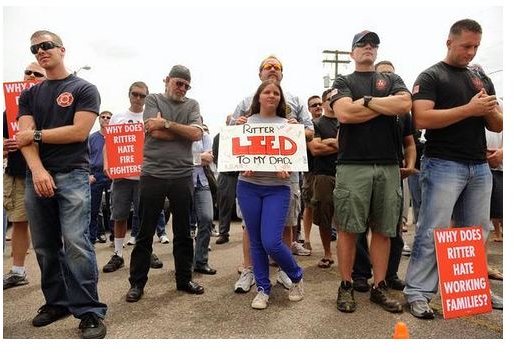What Are the 8 Stages of Collective Bargaining?
Collective bargaining is a dispute redressal mechanism where workers and employers engage in a series of negotiations, and diplomatic and political maneuvers, to effect a collective agreement to resolve the dispute. The scope of the agreement usually relates to terms and conditions of employment, and clarification on rights and responsibilities of workers.
The International Labor Organization lists eight recommended stages of the collective bargaining process: preparing, arguing, signaling, proposing, packaging, bargaining, closing, and agreeing.
Image Credit: Wikimedia Commons
Stage 1: Preparing
The basis of collective bargaining is management engaging in dialog with the workers collectively, and as such, the first stage of collective bargaining is organizing a group to represent the workers. If a trade union exists, then such unions usually take up the role of representing the workers. Otherwise the group is elected.
The group representing workers prepares a list of proposals relating to the issues under dispute, usually related to compensation and working conditions. A pattern of benefits, conditions, rules, and regulations usually exists, and the worker’s proposal aims at highlighting the need for improvements and changes to such work conditions. Such a proposal becomes the basis for the negotiations that follow.
The process of the group of workers framing such a proposal by reconciling the viewpoints of each individual worker is very often tedious and difficult, and takes place through discussions. The meeting ends in consensus, the group leaders taking the majority opinion, or the group leaders adhering to the dominant viewpoint.
The best proposals are ones prepared considering various factors such as internal conditions of the company, the company’s financials, the external environment, and other factors, for the management would invariably counter-argue on such factors.
Stage 2: Arguing
The second stage of collective bargaining is the group representing the workers arguing and substantiating their proposals, and the management counter-arguing, trying to refute the worker’s claims and contentions. The negotiators of both sides use relevant data such as financial figures, precedents, benchmarks, analogies, and other methods, and various methods such as use of logic, appealing to emotions, pleadings, and other techniques to substantiate their point of view.
This stage of collective bargaining starts with both parties stating their case in strong terms, without the two parties discussing or consulting one another. The subsequent arguments and counter arguments can become heated and even acrimonious. Negotiations can break down and resume and the matter remains inconclusive without any progress for many days.
Stage 3: Signaling
This collective bargaining model rests on the worker’s representatives submitting proposals that they consider ideal, but willing to settle for less, and the management willing to concede more than they publicly acknowledge.
Sending signals across to the other party, through subtle messages, change of tone, body language, and other cues reveal to the other side that the proposal under discussion will meet with little resistance, can be accepted with modifications, or have a low chance of acceptance. Signaling thereby, reveals the resistance point to the other party without making it explicit.
Failure to send signals leads to both sides sticking to their positions, causing impasse and a breakdown of negotiation and the dispute escalating to the next level of industrial action.
Stage 4: Proposal

One of the important stages of collective bargaining negotiations is one side making a proposal in a bid to end the argument and reach a settlement. Such proposals are reconciliation of arguments made by either side, based on the signals received.
Image Credit: flickr.com/Bernard Pollack
Stage 5: Packaging
Good negotiators package proposals. Packaging involves making concessions, but placing items that remain too tempting to resist along with some compromises required from the other side, with the condition that the proposal comes as a whole and is not breakable. The other side makes counter-packages.
Stage 6: Bargaining
The packages put forth by either side identify a common ground, or a core that facilitates settlement between the two parties to the dispute. The collective bargaining process, however, continues with each side trying to dilute the other’s package by a counter package, each time saying that this is “last and final” concession they will make.
This session usually involves off the record conversations, some joint exercises to resolve a deadlock, and very often culminate in a marathon round of lengthy and hectic discussions to resolve last minute glitches before both sides finally reach a settlement.
Stage 7: Closing
Closing is the final step in the collective bargaining process. Closing denotes settlement time, or the time negotiation ends. The negotiators walk back over the negotiations and summarize all positions, noting down agreements reached, issues withdrawn, and issued deferred, and clear ambiguities.
Selecting the right time to close depends on the skill of the negotiator. Closing too early may lead to the negotiator’s side losing out on further concessions that the other party may be willing to make, and closing too late may lead to some strategic advantage or position of mutual ground being lost. The prevailing mood of the workers and the economic climate greatly influences the closing time as well.
Stage 8: Agreeing
The final stage of the collective bargaining process is agreeing, or vetting the draft collective bargaining agreement. Discussions in this stage center on date for implementation of the settlement, such as date of payment for revised wages and introduction of new benefits, and other considerations. The process, however, does not end until the principals, that is the owner or stakeholder of the company and the rank and file workforce accept and ratify the agreement struck by the negotiators.
Adhering to the recommended stages of collective bargaining facilitate smooth negotiations and go a long way in effecting a win-win settlement.
Reference
International Labor Organization. “The Collective Bargaining process.” Retrieved from https://www.ilocarib.org.tt/Promalco_tool/productivity-tools/manual10/m10_3.htm on 14 February 2011.
